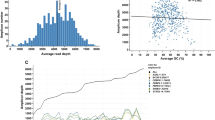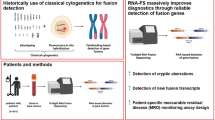Abstract
Background
The use of molecular genetic biomarkers is rapidly advancing to aid diagnosis, prognosis, and clinical management of hematological disorders. We have implemented a next-generation sequencing (NGS) assay for detection of genetic variants and fusions as a frontline test for patients suspected with myeloid malignancy. In this study, we summarize the findings and assess the clinical impact in the first 1613 patients tested.
Methods
All patients were assessed using NGS based Oncomine Myeloid Research Assay (ThermoFisher) including 40 genes (17 full genes and 23 genes with clinically relevant “hotspot” regions), along with a panel of 29 fusion driver genes (including over fusion 600 partners).
Results
Among 1613 patients with suspected myeloid malignancy, 43% patients harbored at least one clinically relevant variant: 91% (90/100) in acute myeloid leukemia patients, 71.7% (160/223) in myelodysplastic syndrome (MDS), 77.5% (308/397) in myeloproliferative neoplasm (MPN), 83% (34/41) in MPN/MDS, and 100% (40/40) in chronic myeloid leukemia patients. Comparison of NGS and cytogenetics results revealed a high degree of concordance in gene fusion detection.
Conclusions
Our findings demonstrate clinical utility and feasibility of integrating a NGS-based gene mutation and fusion testing assay as a frontline diagnostic test in a large reported cohort of patients with suspected myeloid malignancy, in a clinical laboratory setting. Overlap with cytogenetic test results provides opportunity for testing reduction and streamlining.


Similar content being viewed by others
References
Bacher U, Shumilov E, Flach J, Porret N, Joncourt R, Wiedemann G, et al. Challenges in the introduction of next-generation sequencing (NGS) for diagnostics of myeloid malignancies into clinical routine use. Blood Cancer J. 2018;8:113.
Taylor J, Xiao W, Abdel-Wahab O. Diagnosis and classification of hematologic malignancies on the basis of genetics. Blood. 2017;130:410–23.
Patel U, Luthra R, Medeiros LJ, Patel KP. Diagnostic, prognostic, and predictive utility of recurrent somatic mutations in myeloid neoplasms. Clin Lymphoma Myeloma Leuk. 2017;17S:S62.
Yang F, Anekpuritanang T, Press RD. Clinical utility of next-generation sequencing in acute myeloid leukemia. Mol Diagn Ther. 2020;24:1.
Arber DA, Orazi A, Hasserjian R, Thiele J, Borowitz MJ, Le Beau MM, et al. The 2016 revision to the World Health Organization classification of myeloid neoplasms and acute leukemia. Blood. 2016;127:2391.
Swoboda DM, Gesiotto Q, Sallman DA. Novel therapies in myelodysplastic syndromes. Curr Opin Hematol. 2020;27:58.
Blum WG, Mims AS. Treating acute myeloid leukemia in the modern era: a primer. Cancer. 2020. https://doi.org/10.1002/cncr.32904.
Levy MA, Santos S, Kerkhof J, Stuart A, Aref-Eshghi E, Guo F, et al. Implementation of an NGS-based sequencing and gene fusion panel for clinical screening of patients with suspected hematologic malignancies. Eur J Haematol. 2019;103:178.
Li MM, Datto M, Duncavage EJ, Kulkarni S, Lindeman NI, Roy S, et al. Standards and guidelines for the interpretation and reporting of sequence variants in cancer: a joint consensus recommendation of the Association for Molecular Pathology, American Society of Clinical Oncology, and College of American Pathologists. J Mol Diagn. 2017;19:4.
Palomo L, Ibáñez M, Abáigar M, Vázquez I, Álvarez S, Cabezón M, et al. Spanish Guidelines for the use of targeted deep sequencing in myelodysplastic syndromes and chronic myelomonocytic leukaemia. Br J Haematol. 2020;188:605.
McClure RF, Ewalt MD, Crow J, Temple-Smolkin RL, Pullambhatla M, Sargent R, et al. Clinical significance of DNA variants in chronic myeloid neoplasms: a report of the Association for Molecular Pathology. J Mol Diagn. 2018;20:717.
Kennedy JA, Ebert BL. Clinical implications of genetic mutations in myelodysplastic syndrome. J Clin Oncol. 2017;35:968.
Döhner H, Estey E, Grimwade D, Amadori S, Appelbaum FR, Büchner T, et al. Diagnosis and management of AML in adults: 2017 ELN recommendations from an international expert panel. Blood. 2017;129:424.
Walker A, Marcucci G. Molecular prognostic factors in cytogenetically normal acute myeloid leukemia. Expert Rev Hematol. 2012;5:547.
Lin TL, Smith BD. Prognostically important molecular markers in cytogenetically normal acute myeloid leukemia. Am J Med Sci. 2011;341:404.
Lauber C, Correia N, Trumpp A, Rieger MA, Dolnik A, Bullinger L, et al. Survival differences and associated molecular signatures of DNMT3A-mutant acute myeloid leukemia patients. Sci Rep. 2020;10(1):12761. https://doi.org/10.1038/s41598-020-69691-8.
Bezerra MF, Lima AS, Piqué-Borràs MR, Silveira DR, Coelho-Silva JL, Pereira-Martins DA, et al. Co-occurrence of DNMT3A, NPM1, FLT3 mutations identifies a subset of acute myeloid leukemia with adverse prognosis. Blood. 2020;135(11):870–5.
Greenberg PL, Stone RM, Al-Kali A, Barta SK, Bejar R, Bennett JM, et al. Myelodysplastic syndromes, version 2.2017, NCCN clinical practice guidelines in oncology. J Natl Compr Cancer Netw. 2017;15:60.
Hou HA, Tsai CH, Lin CC, Chou WC, Kuo YY, Liu CY, et al. Incorporation of mutations in five genes in the revised International Prognostic Scoring System can improve risk stratification in the patients with myelodysplastic syndrome. Blood Cancer J. 2018;8:39.
Cessna MH, Paulraj P, Hilton B, Sadre-Bazzaz K, Szankasi P, Cluff A, et al. Chronic myelomonocytic leukemia with ETV6-ABL1 rearrangement and SMC1A mutation. Cancer Genet. 2019;238:31–6.
Nazha A, Narkhede M, Radivoyevitch T, Seastone DJ, Patel BJ, Gerds AT, et al. Incorporation of molecular data into the Revised International Prognostic Scoring System in treated patients with myelodysplastic syndromes. Leukemia. 2016;30:2214.
Rosenthal SH, Gerasimova A, Ma C, Li HR, Grupe A, Chong H, et al. Analytical validation and performance characteristics of a 48-gene next-generation sequencing panel for detecting potentially actionable genomic alterations in myeloid neoplasms. PLoS ONE. 2021;16(4): e0243683.
Kawata E, Lazo-Langner A, Xenocostas A, Hsia CC, Howson-Jan K, Deotare U. Clinical value of next-generation sequencing compared to cytogenetics in patients with suspected myelodysplastic syndrome. Br J Haematol. 2021;192(4):729–36.
Kawata E, Hedley BD, Chin-Yee B, Xenocostas A, Lazo-Langner A, Hsia CC. Reducing cytogenetic testing in the era of next generation sequencing: Are we choosing wisely? Int J Lab Hematol. 2021. https://doi.org/10.1111/ijlh.13747.
Loscocco GG, Guglielmelli P, Vannucchi AM. Impact of mutational profile on the management of myeloproliferative neoplasms: a short review of the emerging data. Onco Targets Ther. 2020;1(13):12367–82.
Andréasson B, Pettersson H, Wasslavik C, Johansson P, Palmqvist L, Asp J. ASXL1 mutations, previous vascular complications and age at diagnosis predict survival in 85 WHO-defined polycythaemia vera patients. Br J Haematol. 2020;189(5):913–9.
Palumbo GA, Stella S, Pennisi MS, Pirosa C, Fermo E, Fabris S, Cattaneo D, Iurlo A. The role of new technologies in myeloproliferative neoplasms. Front Oncol. 2019;26(9):321.
Sperling AS, Gibson CJ, Ebert BL. The genetics of myelodysplastic syndrome: from clonal haematopoiesis to secondary leukaemia. Nat Rev Cancer. 2017;17:5.
Ogawa S. Genetics of MDS. Blood. 2019;133:1049.
Papaemmanuil E, Gerstung M, Bullinger L, Gaidzik VI, Paschka P, Roberts ND, et al. Genomic classification and prognosis in acute myeloid leukemia. N Engl J Med. 2016;374:2209.
Patel JP, Gönen M, Figueroa ME, Fernandez H, Sun Z, Racevskis J, et al. Prognostic relevance of integrated genetic profiling in acute myeloid leukemia. N Engl J Med. 2012;366:1079.
Acknowledgements
The authors would like to thank all the laboratory staff at the Pathology and Laboratory Medicine (PALM), London Health Science Center for their significant contributions towards this study.
Author information
Authors and Affiliations
Corresponding authors
Ethics declarations
Ethics Approval and Consent to Participate
Not applicable.
Consent for Publication
Not applicable.
Availability of Data and Material
All data generated or analyzed during this study are included in this published article (and its Online Supplementary Material).
Code availability
Not applicable.
Competing Interests
The authors declare that they have no competing interests.
Funding
The London Health Sciences Centre Molecular Diagnostics Innovation and Development Fund.
Authors' Contributions
PB, LS, and CH analyzed and interpreted the data, wrote the manuscript, and contributed equally towards this study. CH, IC, BH, and AX contributed in providing patients’ clinical information. MAL, AS, RB, BH, SN, and PB compiled the laboratory data. BS, MAL, HL, PY, JK, and SS contributed towards validation and implementation of the NGS-based assay and manuscript editing. BS and IC planned and executed the study and contributed significantly to writing the manuscript.
Supplementary Information
Below is the link to the electronic supplementary material.
40291_2022_581_MOESM1_ESM.xlsx
Supplementary Table 1: Tier I/II variants identified in all patients tested by NGS and gene coverage by NGS (XLSX 116 KB)
40291_2022_581_MOESM3_ESM.xlsx
Supplementary Table 3: Frequency of Tier I/II variants n each clinical group in genes grouped based on cellular processes depicted in Figure 1 (XLSX 13 KB)
Rights and permissions
About this article
Cite this article
Bhai, P., Hsia, C.C., Schenkel, L.C. et al. Clinical Utility of Implementing a Frontline NGS-Based DNA and RNA Fusion Panel Test for Patients with Suspected Myeloid Malignancies. Mol Diagn Ther 26, 333–343 (2022). https://doi.org/10.1007/s40291-022-00581-7
Accepted:
Published:
Issue Date:
DOI: https://doi.org/10.1007/s40291-022-00581-7




